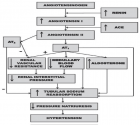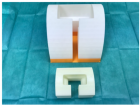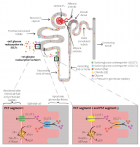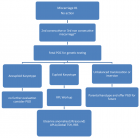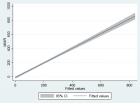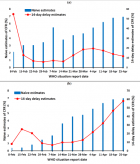Abstract
Research Article
The Renin-Angiotensin System: Alamandine is reduced in patients with Idiopathic Pulmonary Fibrosis
Taís Salvi Sipriani, Robson Augusto Souza dos Santos and Katya Rigatto*
Published: 20 November, 2019 | Volume 4 - Issue 3 | Pages: 210-215
Idiopathic Pulmonary Fibrosis (IPF) is a chronic and progressive disease without treatment that leads to death. Therefore, to control its progression to pulmonary hypertension is still a challenge. Moreover, there is no study that has investigated the Renin-Angiotensin System in patients with IPF.
Objective: Verify the plasma concentrations of Angiotensin I, Angiotensin II (AngII), Angiotensin-(1-7) [Ang- (1-7)] and Alamandine in patients with IPF.
Methods: Ten IPF patients, with or without PH, were included, and ten controls matched by sex and age. Quantitative plasma peptide concentrations (PPC) were expressed as mean and standard deviation or median and interquartile range. The Student Newman-Keuls t test was used for parametric data, Mann-Whitney for nonparametric data and, to compare proportions, the Fisher exact test was performed. The associations between clinical variables and the PPC were evaluated by Pearson or Spearman correlation coefficients. A p ≤ 0.05 was considered statistically significant.
Results: The Alamandine plasma concentration was significantly (365%) lower in the IPF group and positively associated (r = 0.876) with pulmonary artery pressure (PAP). In addition, only in control group, the forced expiratory volume (FEV1%) was positively associated (p = 0.758) with Ang-(1-7).
Conclusion: This study showed, for the first time, that there is a decrease in Alamandine participation in patients with IPF. The ACE-AngII-AT1 axis may be more active in this disease. In addition, our results suggest that Alamandine might be compensating the increase in PAP, as well as the Ang-(1-7) is improving the forced expiratory volume.
Read Full Article HTML DOI: 10.29328/journal.jccm.1001070 Cite this Article Read Full Article PDF
Keywords:
Idiopathic-Pulmonary-Fibrosis; Alamandine; Renin-Angiotensin System
References
- Navaratnam V, Fleming KM, West J, Smith CJ, Jenkins RG, et al. The rising incidence of idiopathic pulmonary fibrosis in the U.K. Thorax. 2011; 66: 462-467. PubMed: https://www.ncbi.nlm.nih.gov/pubmed/21525528
- Raghu G, Weycker D, Edelsberg J, Bradford WZ, Oster G. Incidence and prevalence of idiopathic pulmonary fibrosis. Am J Respir Crit Care Med. 2006; 174: 810-816. PubMed: https://www.ncbi.nlm.nih.gov/pubmed/16809633
- Selman M, King TE, Pardo A; American Thoracic Society; European Respiratory Society, et al. Idiopathic pulmonary fibrosis: prevailing and evolving hypotheses about its pathogenesis and implications for therapy. Ann Intern Med. 2001; 134: 136-151. PubMed: https://www.ncbi.nlm.nih.gov/pubmed/11177318
- Yan Z, Kui Z, Ping Z. Reviews and prospectives of signaling pathway analysis in idiopathic pulmonary fibrosis. Autoimmun Rev. 2014; 13: 1020-1025. PubMed: https://www.ncbi.nlm.nih.gov/pubmed/25182202
- Raghu G, Collard HR, Egan JJ, Martinez FJ, Behr J, et al. An official ATS/ERS/JRS/ALAT statement: idiopathic pulmonary fibrosis: evidence-based guidelines for diagnosis and management. Am J Respir Crit Care Med. 2011; 183: 788-824. PubMed: https://www.ncbi.nlm.nih.gov/pubmed/21471066
- Lettieri CJ, Nathan SD, Barnett SD, Ahmad S, Shorr AF. Prevalence and outcomes of pulmonary arterial hypertension in advanced idiopathic pulmonary fibrosis. Chest. 2006; 129: 746-752. PubMed: https://www.ncbi.nlm.nih.gov/pubmed/16537877
- Woodcock HV, Maher TM. The treatment of idiopathic pulmonary fibrosis. F1000Prime Rep. 2014; 6: 16. PubMed: https://www.ncbi.nlm.nih.gov/pubmed/24669297
- Li X, Molina-Molina M, Abdul-Hafez A, Uhal V, Xaubet A, et al. Angiotensin converting enzyme-2 is protective but downregulated in human and experimental lung fibrosis. Am J Physiol Lung Cell Mol Physiol. 2008; 295: L178-185. PubMed: https://www.ncbi.nlm.nih.gov/pubmed/18441099
- Molteni A, Wolfe LF, Ward WF, Ts'ao CH, Molteni LB, et al. Effect of an angiotensin II receptor blocker and two angiotensin converting enzyme inhibitors on transforming growth factor-beta (TGF-beta) and alpha-actomyosin (alpha SMA), important mediators of radiation-induced pneumopathy and lung fibrosis. Curr Pharm Des. 2007; 13: 1307-1316. PubMed: https://www.ncbi.nlm.nih.gov/pubmed/17506716
- Uhal BD, Kim JK, Li X, Molina-Molina M. Angiotensin-TGF-beta 1 crosstalk in human idiopathic pulmonary fibrosis: autocrine mechanisms in myofibroblasts and macrophages. Curr Pharm Des. 2007; 13: 1247-1256. PubMed: https://www.ncbi.nlm.nih.gov/pubmed/17504233
- Uhal BD, Li X, Piasecki CC, Molina-Molina M. Angiotensin signalling in pulmonary fibrosis. Int J Biochem Cell Biol. 2012; 44: 465-468. PubMed: https://www.ncbi.nlm.nih.gov/pubmed/22155301
- Kim S, Iwao H. Molecular and cellular mechanisms of angiotensin II-mediated cardiovascular and renal diseases. Pharmacol Rev. 2000; 52: 11-34. PubMed: https://www.ncbi.nlm.nih.gov/pubmed/10699153
- Mehta PK, Griendling KK. Angiotensin II cell signaling: physiological and pathological effects in the cardiovascular system. Am J Physiol Cell Physiol. 2007; 292: C82-97. PubMed: https://www.ncbi.nlm.nih.gov/pubmed/16870827
- Ferrario CM, Chappell MC, Tallant EA, Brosnihan KB, Diz DI. Counterregulatory actions of angiotensin-(1-7). Hypertension. 1997; 30: 535541. PubMed: https://www.ncbi.nlm.nih.gov/pubmed/9322978
- Santos RA, Simoes e Silva AC, Maric C, Silva DM, Machado RP, et al. Angiotensin-(1-7) is an endogenous ligand for the G protein-coupled receptor Mas. Proc Natl Acad Sci U S A. 2003; 100: 8258-8263. PubMed: https://www.ncbi.nlm.nih.gov/pubmed/12829792
- Tallant EA, Ferrario CM, Gallagher PE. Angiotensin-(1-7) inhibits growth of cardiac myocytes through activation of the mas receptor. Am J Physiol Heart Circ Physiol. 2005; 289: H1560-1566. PubMed: https://www.ncbi.nlm.nih.gov/pubmed/15951342
- Shenoy V, Ferreira AJ, Qi Y, Fraga-Silva RA, Díez-Freire C, et al. The angiotensin-converting enzyme 2/angiogenesis-(17)/Mas axis confers cardiopulmonary protection against lung fibrosis and pulmonary hypertension. Am J Respir Crit Care Med. 2010; 182: 1065-1072. PubMed: https://www.ncbi.nlm.nih.gov/pubmed/20581171
- Uhal BD, Li X, Xue A, Gao X, Abdul-Hafez A. Regulation of alveolar epithelial cell survival by the ACE-2/angiotensin 1-7/Mas axis. Am J Physiol Lung Cell Mol Physiol. 2011; 301: L269-274. PubMed: https://www.ncbi.nlm.nih.gov/pubmed/21665960
- Lautner RQ, Villela DC, Fraga-Silva RA, Silva N, Verano-Braga T, et al. Discovery and characterization of alamandine: a novel component of the renin-angiotensin system. Circ Res. 2013; 112: 1104-1111. PubMed: https://www.ncbi.nlm.nih.gov/pubmed/23446738
- Mendoza-Torres E, Oyarzún A, Mondaca-Ruff D, Azocar A, Castro PF, et al. ACE2 and vasoactive peptides: novel players in cardiovascular/renal remodeling and hypertension. Ther Adv Cardiovasc Dis. 2015; 9: 217-237. PubMed: https://www.ncbi.nlm.nih.gov/pubmed/26275770
- ATS statement: guidelines for the sixminute walk test. ATS statement: guidelines for the six-minute walk test. Am J Respir Crit Care Med. 2002; 166: 111-117. PubMed: https://www.ncbi.nlm.nih.gov/pubmed/12091180
- Alakhras M, Decker PA, Nadrous HF, Collazo-Clavell M, Ryu JH. Body mass index and mortality in patients with idiopathic pulmonary fibrosis. Chest. 2007; 131: 1448-1453. PubMed: https://www.ncbi.nlm.nih.gov/pubmed/17400656
- Bunn HF, Poyton RO. Oxygen sensing and molecular adaptation to hypoxia. Physiol Rev. 1996; 76: 839-885. PubMed: https://www.ncbi.nlm.nih.gov/pubmed/8757790
- Davis PB. Cystic fibrosis since 1938. Am J Respir Crit Care Med. 2006; 173: 475-482. PubMed: https://www.ncbi.nlm.nih.gov/pubmed/16126935
- Stark LJ, Powers SW. Behavioral aspects of nutrition in children with cystic fibrosis. Curr Opin Pulm Med. 2005; 11: 539-542. https://www.ncbi.nlm.nih.gov/pubmed/16217182
- Hsieh MJ, Yang TM, Tsai YH. Nutritional supplementation in patients with chronic obstructive pulmonary disease. J Formos Med Assoc. 2016; 115: 595-601. PubMed: https://www.ncbi.nlm.nih.gov/pubmed/26822811
- Königshoff M, Wilhelm A, Jahn A, Sedding D, Amarie OV, et al. The angiotensin II receptor 2 is expressed and mediates angiotensin II signaling in lung fibrosis. Am J Respir Cell Mol Biol. 2007; 37: 640-650. PubMed: https://www.ncbi.nlm.nih.gov/pubmed/17630322
- Li X, Molina-Molina M, Abdul-Hafez A, Ramirez J, Serrano-Mollar A, et al. Extravascular sources of lung angiotensin peptide synthesis in idiopathic pulmonary fibrosis. Am J Physiol Lung Cell Mol Physiol. 2006; 291: L887-895. PubMed: https://www.ncbi.nlm.nih.gov/pubmed/16844946
- Li X, Rayford H, Uhal BD. Essential roles for angiotensin receptor AT1a in bleomycin-induced apoptosis and lung fibrosis in mice. Am J Pathol. 2003; 163: 2523-2530. PubMed: https://www.ncbi.nlm.nih.gov/pubmed/14633624
- Meng Y, Meng Y, Li X, Cai SX, Tong WC, et al. [Perindopril and losartan attenuate bleomycin A5-induced pulmonary fibrosis in rats]. Nan Fang Yi Ke Da Xue Xue Bao. 2008; 28: 919-924. PubMed: https://www.ncbi.nlm.nih.gov/pubmed/18583228
- Mohammadi-Karakani A1, Ghazi-Khansari M, Sotoudeh M. Lisinopril ameliorates paraquat-induced lung fibrosis. Clin Chim Acta. 2006; 367: 170-174. PubMed: https://www.ncbi.nlm.nih.gov/pubmed/16458281
- Wang R, Ibarra-Sunga O, Verlinski L, Pick R, Uhal BD. Abrogation of bleomycin-induced epithelial apoptosis and lung fibrosis by captopril or by a caspase inhibitor. Am J Physiol Lung Cell Mol Physiol. 2000; 279: L143-151. PubMed: https://www.ncbi.nlm.nih.gov/pubmed/10893213
- Jiang T, Tan L, Gao Q, Lu H, Zhu XC, et al. Plasma angiotensin-(1-7) is a potential biomarker for Alzheimer's disease. Curr Neurovasc Res. 2016. PubMed: https://www.ncbi.nlm.nih.gov/pubmed/26907614
- Etelvino GM, Peluso AA, Santos RA. New components of the reninangiotensin system: alamandine and the MAS-related G protein-coupled receptor D. Curr Hypertens Rep. 2014; 16: 433. PubMed: https://www.ncbi.nlm.nih.gov/pubmed/24760442
- Grobe JL, Mecca AP, Lingis M, Shenoy V, Bolton TA, et al. Prevention of angiotensin II-induced cardiac remodeling by angiotensin-(1-7). Am J Physiol Heart Circ Physiol. 2007; 292: H736-742. PubMed: https://www.ncbi.nlm.nih.gov/pubmed/17098828
Figures:
Similar Articles
-
The Renin-Angiotensin System: Alamandine is reduced in patients with Idiopathic Pulmonary FibrosisTaís Salvi Sipriani,Robson Augusto Souza dos Santos,Katya Rigatto*. The Renin-Angiotensin System: Alamandine is reduced in patients with Idiopathic Pulmonary Fibrosis. . 2019 doi: 10.29328/journal.jccm.1001070; 4: 210-215
Recently Viewed
-
Advancements in Clinical Research: Phases, Ethical Considerations, and Technological InnovationsAshish Pandey*. Advancements in Clinical Research: Phases, Ethical Considerations, and Technological Innovations. Arch Case Rep. 2024: doi: 10.29328/journal.acr.1001102; 8: 084-086
-
Comparative Studies of Diclofenac Sodium (NSAID) Adsorption on Wheat (Triticum aestivum) Bran and Groundnut (Arachis hypogaea) Shell Powder using Vertical and Sequential Bed ColumnNeha Dhiman*. Comparative Studies of Diclofenac Sodium (NSAID) Adsorption on Wheat (Triticum aestivum) Bran and Groundnut (Arachis hypogaea) Shell Powder using Vertical and Sequential Bed Column. Ann Adv Chem. 2024: doi: 10.29328/journal.aac.1001052; 8: 021-029
-
Simple Modified Transvesical Prostatectomy with Minimum Incision and Endoscopic Vascular Control: A Case ReportAntônio Carlos Oliveira Almeida*,Anuar Ibrahim Mitre,Elcio Dias Silva*. Simple Modified Transvesical Prostatectomy with Minimum Incision and Endoscopic Vascular Control: A Case Report. Arch Case Rep. 2025: doi: 10.29328/journal.acr.1001119; 9: 001-003
-
Localization of the occluded vessel in acute myocardial infarctionSamir Rafla*,Amr Kamal. Localization of the occluded vessel in acute myocardial infarction. J Cardiol Cardiovasc Med. 2020: doi: 10.29328/journal.jccm.1001082; 5: 029-033
-
Acyclovir Induced Acute Kidney Injury: A Case ReportZiauddin Mohammed*, Mariya Zoha Muskan, Megha Mohan Narayanan. Acyclovir Induced Acute Kidney Injury: A Case Report. Arch Pharm Pharma Sci. 2024: doi: 10.29328/journal.apps.1001048; 8: 001-002
Most Viewed
-
Evaluation of Biostimulants Based on Recovered Protein Hydrolysates from Animal By-products as Plant Growth EnhancersH Pérez-Aguilar*, M Lacruz-Asaro, F Arán-Ais. Evaluation of Biostimulants Based on Recovered Protein Hydrolysates from Animal By-products as Plant Growth Enhancers. J Plant Sci Phytopathol. 2023 doi: 10.29328/journal.jpsp.1001104; 7: 042-047
-
Sinonasal Myxoma Extending into the Orbit in a 4-Year Old: A Case PresentationJulian A Purrinos*, Ramzi Younis. Sinonasal Myxoma Extending into the Orbit in a 4-Year Old: A Case Presentation. Arch Case Rep. 2024 doi: 10.29328/journal.acr.1001099; 8: 075-077
-
Feasibility study of magnetic sensing for detecting single-neuron action potentialsDenis Tonini,Kai Wu,Renata Saha,Jian-Ping Wang*. Feasibility study of magnetic sensing for detecting single-neuron action potentials. Ann Biomed Sci Eng. 2022 doi: 10.29328/journal.abse.1001018; 6: 019-029
-
Pediatric Dysgerminoma: Unveiling a Rare Ovarian TumorFaten Limaiem*, Khalil Saffar, Ahmed Halouani. Pediatric Dysgerminoma: Unveiling a Rare Ovarian Tumor. Arch Case Rep. 2024 doi: 10.29328/journal.acr.1001087; 8: 010-013
-
Physical activity can change the physiological and psychological circumstances during COVID-19 pandemic: A narrative reviewKhashayar Maroufi*. Physical activity can change the physiological and psychological circumstances during COVID-19 pandemic: A narrative review. J Sports Med Ther. 2021 doi: 10.29328/journal.jsmt.1001051; 6: 001-007

HSPI: We're glad you're here. Please click "create a new Query" if you are a new visitor to our website and need further information from us.
If you are already a member of our network and need to keep track of any developments regarding a question you have already submitted, click "take me to my Query."






